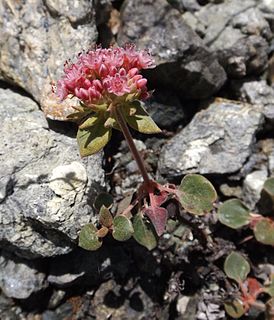
Eriogonum fasciculatum is a species of wild buckwheat known by the common names California buckwheat and flat-topped buckwheat. Characterized by small, white and pink flower clusters that give off a cottony effect, this species grows variably from a patchy mat to a wide shrub, with the flowers turning a rusty color after blooming. This plant is of great benefit across its various habitats, providing an important food resource for a diversity of insect and mammal species. It also provides numerous ecosystem services for humans, including erosion control, post-fire mitigation, increases in crop yields when planted in hedgerows, and high habitat restoration value.
Eriogonum gilmanii is a species of wild buckwheat known by the common name Gilman's buckwheat. This plant is endemic to Inyo County, California, where it is known only from the desert mountain slopes of the Cottonwood, Last Chance, and Panamint Ranges. This is a flat mat-forming, woody perennial herb which grows in patches under 20 centimeters wide on rocky soils. Its tiny fleshy leaves, each under half a centimeter wide, are covered in a dense hairy white wool. The plant blooms in showy erect heads of small, inflated flowers, each a few millimeters wide and yellowish or orange with red stripes.

Eriogonum gracilipes is a species of wild buckwheat known by the common name White Mountains buckwheat.

Eriogonum hirtellum is a species of wild buckwheat known by the common name Klamath Mountain buckwheat. It is endemic to the Klamath Mountains of far northern California, where it is known from only a few occurrences.

Eriogonum incanum is a species of wild buckwheat known by the common name frosted buckwheat. It is native to the Sierra Nevada of California and extreme western Nevada. It is also known from Oregon.

Eriogonum marifolium is a species of wild buckwheat known by the common name marumleaf buckwheat. It is native to the Sierra Nevada and Klamath Mountains of California and the ranges' extensions into Oregon and Nevada.

Eriogonum nervulosum is a species of wild buckwheat known by the common name Snow Mountain buckwheat. This uncommon plant is endemic to the inland North Coast Ranges of California, where it is known from only a handful of occurrences, most of which are in Lake County. It is named for Snow Mountain, a local peak.

Eriogonum ovalifolium is a species of wild buckwheat known by the common name cushion buckwheat. It is native to western North America from California to Alberta, where it is a member of many plant communities in varied habitats, including the sagebrush steppe and alpine regions.

Eriogonum rosense is a species of wild buckwheat known by the common name rosy buckwheat. It is native to the mountains of eastern California and its range extends into Nevada.

Eriogonum saxatile is a species of wild buckwheat known by the common name hoary buckwheat. It is native to the dry, rocky mountain slopes of California and Nevada, where it is a common plant.

Eriogonum strictum is a species of wild buckwheat known by the common name Blue Mountain buckwheat. It is a common plant of western North America from northern California to British Columbia where it is found along rocky slopes and scrubland. It flowers early in the summer.

Eriogonum flavum is a species of wild buckwheat.

Eriogonum grande is a species of wild buckwheat known by the common name redflower buckwheat. It is native to northwestern Baja California, as well as the Channel Islands of California. It is a mat-forming perennial herb producing tall, stout inflorescences of white, pink, or red flowers. Leaves are located mainly at the base of the plant and are wavy along the edges and up to 10 centimeters long.

Eriogonum kennedyi is a species of wild buckwheat known by the common name Kennedy's buckwheat.

Eriogonum siskiyouense is a rare species of wild buckwheat known by the common name Siskiyou buckwheat.

Eriogonum callistum is a rare species of wild buckwheat, known by the common name Tehachapi buckwheat.

Eriogonum gypsophilum is a rare species of wild buckwheat known by the common names Seven River Hills buckwheat and gypsum wild buckwheat. It is endemic to the state of New Mexico in the United States, where it is known from only three sites in Eddy County. It is limited to a specific type of soil which is high in gypsum. The plant has been federally listed as a threatened species of the United States since 1981.

Eriogonum argophyllum is a species of wild buckwheat known by the common names Sulphur Hot Springs buckwheat, Silver Lake buckwheat, and Ruby Valley buckwheat. It is endemic to Nevada in the United States, where there is only one known population.
Eriogonum codium is a species of wild buckwheat known by the common names basalt desert buckwheat and Umtanum Desert wild buckwheat. It is endemic to Washington in the United States, where it is known only from Hanford Reach National Monument in Benton County. It was discovered in 1995 during an inventory of the biodiversity of the monument and described to science in 1997.

The flora of the U.S. Sierra Nevada alpine zone is characterized by small, low growing, cushion and mat forming plants that can survive the harsh conditions in the high-altitude alpine zone above the timber line. These flora often occur in alpine fell-fields. The Sierra Nevada alpine zone lacks a dominant plant species that characterizes it, so may or may not be called a vegetation type. But it is found above the subalpine forest, which is the highest in a succession of recognized vegetation types at increasing elevations.


















